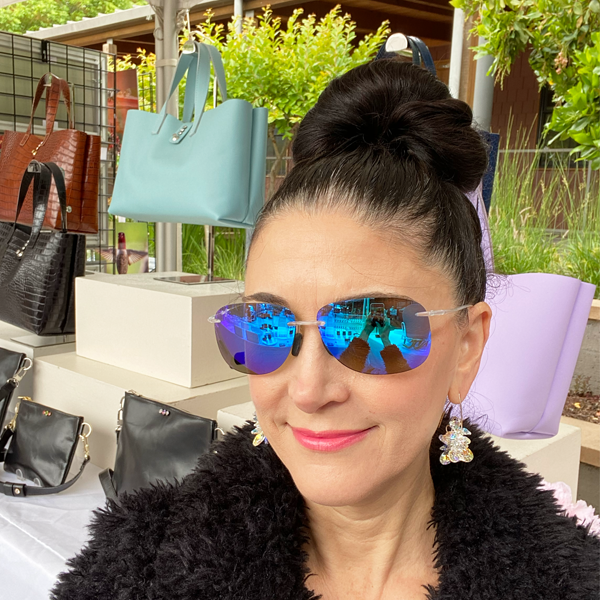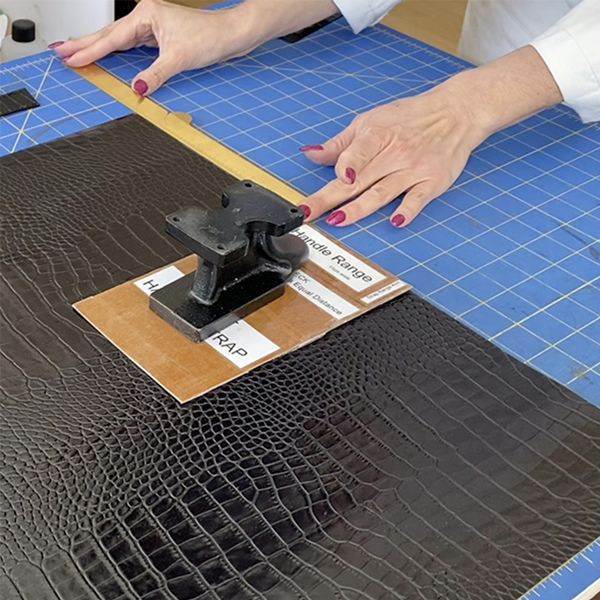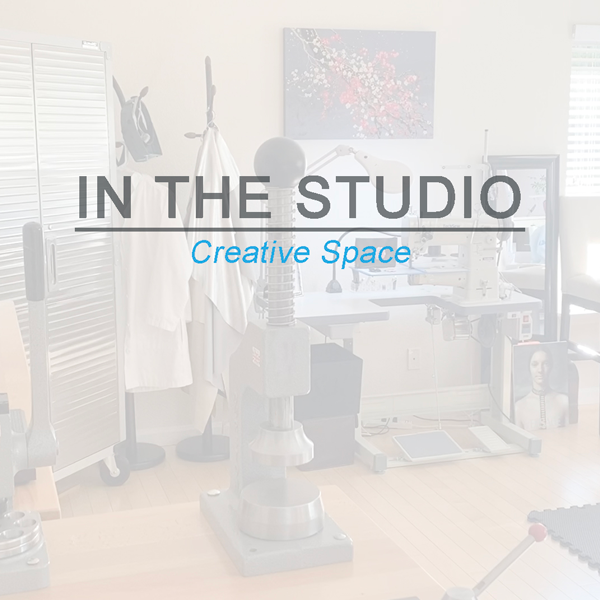A Day In the Life of an Entrepreneur Part 3 - Making a Gemstone Ring

I wear many hats in my job and outfits too!
A Day in the Life of a Jewelry Designer
A day in the life of an entrepreneur for me is different every day, as I mentioned in the last two blog posts. In PART 1 of this blog I took readers through the experience and schedule of doing an outdoor August show in Silicon Valley. In PART 2 I explained what a day in the life of a handbag designer looks like during the design-to-production process of hand making leather bags.
In Part 3 I will take readers through my experience of working at the bench and hand making a gemstone ring — designing a thick sterling silver blush topaz ring. So, here is a day in the life of a jewelry designer in great detail…
“Accept the unexpected.”

Creative Process
2:20 am: It’s a Tuesday March morning and I am laying in bed thinking about the handmade ring I will make today. I can’t sleep. My brain is thinking about what I want to accomplish. Every designer has their own creative process. Mine isn’t sketched on a piece of paper, but a photograph in my mind. Creative ideas come to me at the strangest times — 2 am can’t-sleep moments (often), in the shower, driving, folding laundry, randomly, or by a huge project disaster — which is bittersweet. At times I write my ideas down so I don’t forget the thought.
5:00 am: I finally fall asleep.

7:37 am: I get up and feed my beloved twenty-two year old kitty, Boo Boo. Every morning she looks forward to her morning meal and greets me with those blurry eyes.
8:15 am: Morning domestic tasks done — made bed, unloaded dishes, and a load of laundry is in the machine. I am ready to start work and get my hands dirty.
8:20 am: Sipping my coffee, I work on show applications. Yes, all these shows I do I have to apply for, go through a jury process, and pay for. The competition never ends! More details on that in another post :-)

9:40 am: I am ready to work at the bench. Keep in mind that each artist has their own style and techniques for creating a piece of jewelry, therefore my process can be entirely different than another designer. Before designing any piece of jewelry I first map out the steps and materials required. Now let’s go behind the scenes of making a sterling gemstone ring… My creative process includes:
First step, a list of all materials required for the ring design. For example, what type of metals, gemstones, and how much material is required? What is the size of the ring, gemstone millimeter, and what type of setting? After establishing the specifications I use a formula that tells me how much metal is needed for the ring piece and the setting. Next, reviewing the tools needed for the project. Some of the tools include an electronic digital caliper, hammers, pliers, setting burs, mandrels, burnishers and the list goes on.
This design required specific equipment such as soldering equipment, a microscope, ring micro motor and flex shaft. As you can see, just the planning process takes time and we haven’t even started to make the ring yet. Sometimes when starting a project I double check my design notes from previous projects to ensure I am not forgetting any specific technique. Since I create in two mediums — leather bags and metal jewelry — I have to adapt to that specific skill set during production and previous notes will help with this process.

Making the Ring Pieces
10:05 am: Making a ring with a bezel setting requires two pieces — the ring band design and the bezel cup for the faceted gemstone to sit. When making a bezel setting the dimensions have to be just right or else the stone won’t fit properly. So, once I have the ring size, gemstone millimeters and metal specifications I use a formula to calculate the size specifications. Next, I mark the measurement on the metal with a scribe and digital caliper. Now I am ready to saw the metal.

10:20 am: Now it is time to cut the ring and bezel cup. Taking each metal piece, I carefully saw the dimensions. Metals can harden while working with, so at times annealing is required — softening metal with a torch. When cutting metal it is important not to cut too much or too little. If you end up cutting too much metal you have to start all over, and too much means a lot of sanding or risk trying to cut the excess with a saw again. It is a fine balance, not always achieved.
10:35 am: Now that the sawing is done I have to shape the ring and bezel cup. During this process the metal for both pieces is getting hard from working with it, so annealing is required. I run downstairs to my soldering station to anneal the pieces.
10:50 am: Now I am back upstairs shaping the ring and bezel. These metals are thick and require lots of strength. I think I need to go back to lifting weights — it certainly would help working with these thicker metals.

11:50 am: Oh those pieces were tough shaping. It took longer than I liked and I’m happy I didn’t damage my fingers in the process. The next step: get the metal joints perfectly aligned and clean for soldering. When soldering metals the joints have to meet and connect together without gaps. Soldering won’t work unless the joints meet and are clean. So, fingers stay away from the joints. Now it is time to solder.
Soldering
12:00 pm: I run downstairs to my solder station, plug in the pickle pot and get ready for soldering. Soldering requires two hands and in some cases three or four. The third and fourth are a tool of course, but I wish I had three hands during soldering. That would make the soldering process a lot smoother.
Before soldering I use a solution on the metal pieces to prevent fire scale. Fire scale occurs when oxygen in the air comes into contact with the surface of metal, oxidizing the copper in the metal — bringing copper oxide to the surface — resulting in unattractive purple and pink colors on your jewelry piece. I love the colors purple and pink, just not on my freshly soldered pieces. Fire stain is a huge nightmare to clean-up and extra unnecessary work — removing multiple layers of metal to get the spots out. Using fire scale preventatives is not 100% guaranteed to prevent it, but helps significantly.
Video features some steps that go into making a gemstone ring.
Now it is time to set up the metal piece to be soldered. When soldering, metal and solder like to dance (aka move). It is important to secure the pieces before turning on that torch and manage while soldering — lots of multitasking. It takes practice and mistakes to get it right — I have had plenty of both.
I have prepped the metal bezel cup piece for soldering. Once secure, I place some flux (helps the solder flow) on the soldering area of the bezel cup. First I get my tiny solder pieces ready and torch them to create small little balls. With one hand, I pick up one solder ball with a soldering pick. Then the other hand holding the torch. I start to heat the metal piece. As the piece heats up I take the soldering ball on my pick and place it on the area where it should flow. Once the solder flows then move the torch immediately. If you use too much solder it can be a nightmare to clean up and not enough means you have to solder again. Again, a fine balance.
After the soldered piece cools it goes in the pickle pot, a mixture of a liquid compound used to remove oxidation and flux from the soldered piece for a few minutes. The pickle is an acid that can easily irritate skin and burn holes in clothes if touched. I always use copper prongs to get the pieces out of the pickle pot and then place it carefully in water to remove the acid. After pickling I inspect the piece to ensure the soldering process is successful — sometimes there isn’t enough solder and it requires more soldering.
12:20 pm: I run upstairs to my studio and get working on shaping the bezel cup with a hammer and small mandrel. The metal is thick. I work with it a bit and then run back downstairs to anneal it. You may wonder why I don’t have my soldering station in my studio. The reason — I don’t want the fumes in the house. I prefer all soldering and heavy polishing to be done in a different area where it can withstand fumes and enormous amounts of dust. Running up and down the stairs all day keeps me in shape, reduces my hip and back which is aggravated from sitting in one spot. I clean up the scratches on the ring from bending it with tools and hammering — sanding and smoothing those areas.
1:50 pm: Oops… forgot about food. Happens a lot, because I get super focused. Time for a quick bite… avocado toast… not toasted is my go-to lunch.

Shaping and Clean-up
2:05 pm: Finally the bezel piece is starting to look good — just a little more shaping followed by solder clean up with a micro motor tool. Soon it will be ready for a polish, final inspection before soldering it onto the ring.

2:45 pm: The bezel cup is now ready to be soldered onto the ring. I run downstairs and start the soldering process. I carefully solder the bezel cup on the ring. After removing it from the pickle, I inspect the ring to make sure the soldering is complete. I do a little more clean up and 925 stamp the inside of the ring followed by another polish before setting the ring.

Stone Setting
4:50 pm: The ring is ready for stone setting tomorrow. Setting this stone is going to be a beast, because the metal is very thick. I love designing with thick metals although they can be challenging to work with — it is a love hate relationship for me.
Tomorrow will be a full day of setting this beautiful topaz stone, followed by the final polishing tasks. The stone setting process is a combination of drilling the correct size seat for the stone to sit in, keeping the stone level, using a reciprocating hammer hand piece to move the metal, burnishing the metal with setting tools, and using a microscope to ensure each step is correct. I accept the unexpected during this process — it is part of the journey creating with my hands. Tomorrow is a new day…
“Stone setting has taught me the art of patience”








Leave a comment